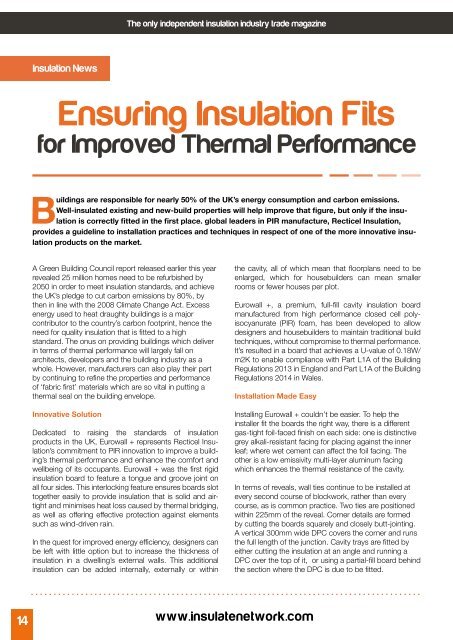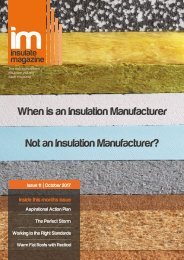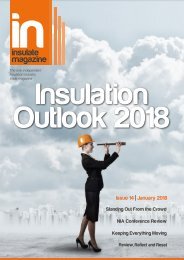IN_Dec_18_Final_SP
An Insulation Evolution is upon us in Insulate Magazine Issue 13. Q-bot a Robot that applies sprayfoam insulation under floors is set to take the insulation world by storm. Also features compelling articles from regular columnists and insulation experts.
An Insulation Evolution is upon us in Insulate Magazine Issue 13. Q-bot a Robot that applies sprayfoam insulation under floors is set to take the insulation world by storm. Also features compelling articles from regular columnists and insulation experts.
You also want an ePaper? Increase the reach of your titles
YUMPU automatically turns print PDFs into web optimized ePapers that Google loves.
The only independent insulation industry trade magazine<br />
Insulation News<br />
Ensuring Insulation Fits<br />
for Improved Thermal Performance<br />
Buildings are responsible for nearly 50% of the UK’s energy consumption and carbon emissions.<br />
Well-insulated existing and new-build properties will help improve that figure, but only if the insulation<br />
is correctly fitted in the first place. global leaders in PIR manufacture, Recticel Insulation,<br />
provides a guideline to installation practices and techniques in respect of one of the more innovative insulation<br />
products on the market.<br />
A Green Building Council report released earlier this year<br />
revealed 25 million homes need to be refurbished by<br />
2050 in order to meet insulation standards, and achieve<br />
the UK’s pledge to cut carbon emissions by 80%, by<br />
then in line with the 2008 Climate Change Act. Excess<br />
energy used to heat draughty buildings is a major<br />
contributor to the country’s carbon footprint, hence the<br />
need for quality insulation that is fitted to a high<br />
standard. The onus on providing buildings which deliver<br />
in terms of thermal performance will largely fall on<br />
architects, developers and the building industry as a<br />
whole. However, manufacturers can also play their part<br />
by continuing to refine the properties and performance<br />
of ‘fabric first’ materials which are so vital in putting a<br />
thermal seal on the building envelope.<br />
Innovative Solution<br />
Dedicated to raising the standards of insulation<br />
products in the UK, Eurowall + represents Recticel Insulation’s<br />
commitment to PIR innovation to improve a building’s<br />
thermal performance and enhance the comfort and<br />
wellbeing of its occupants. Eurowall + was the first rigid<br />
insulation board to feature a tongue and groove joint on<br />
all four sides. This interlocking feature ensures boards slot<br />
together easily to provide insulation that is solid and airtight<br />
and minimises heat loss caused by thermal bridging,<br />
as well as offering effective protection against elements<br />
such as wind-driven rain.<br />
In the quest for improved energy efficiency, designers can<br />
be left with little option but to increase the thickness of<br />
insulation in a dwelling’s external walls. This additional<br />
insulation can be added internally, externally or within<br />
the cavity, all of which mean that floorplans need to be<br />
enlarged, which for housebuilders can mean smaller<br />
rooms or fewer houses per plot.<br />
Eurowall +, a premium, full-fill cavity insulation board<br />
manufactured from high performance closed cell polyisocyanurate<br />
(PIR) foam, has been developed to allow<br />
designers and housebuilders to maintain traditional build<br />
techniques, without compromise to thermal performance.<br />
It’s resulted in a board that achieves a U-value of 0.<strong>18</strong>W/<br />
m2K to enable compliance with Part L1A of the Building<br />
Regulations 2013 in England and Part L1A of the Building<br />
Regulations 2014 in Wales.<br />
Installation Made Easy<br />
Installing Eurowall + couldn’t be easier. To help the<br />
installer fit the boards the right way, there is a different<br />
gas-tight foil-faced finish on each side: one is distinctive<br />
grey alkali-resistant facing for placing against the inner<br />
leaf; where wet cement can affect the foil facing. The<br />
other is a low emissivity multi-layer aluminum facing<br />
which enhances the thermal resistance of the cavity.<br />
In terms of reveals, wall ties continue to be installed at<br />
every second course of blockwork, rather than every<br />
course, as is common practice. Two ties are positioned<br />
within 225mm of the reveal. Corner details are formed<br />
by cutting the boards squarely and closely butt-jointing.<br />
A vertical 300mm wide DPC covers the corner and runs<br />
the full length of the junction. Cavity trays are fitted by<br />
either cutting the insulation at an angle and running a<br />
DPC over the top of it, or using a partial-fill board behind<br />
the section where the DPC is due to be fitted.<br />
14<br />
www.insulatenetwork.com













